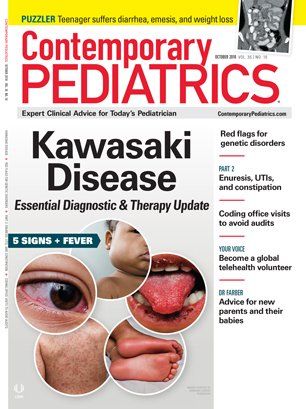Riddle me this: Genetics
If it's been a while since you confidently knew your genotypes from your phenotypes, here are 6 questions to test your genetic knowledge and see how you stack against your pediatric peers.

Contemporary Pediatrics is introducting a new feature that will test your smarts on a clinical topic. This month we're testing you with 6 questions on the topic of genetics. You're going to test your knowledge against your peers by seeing how you stack up with each question.
Answer: C. Disease in the presence of known risk factors
Actually, occurrence of a disorder in the absence of obvious environmental factors may be attributed to a genetic predisposition. An example might be the finding of high cholesterol or undesirable levels of cholesterol in an individual with an ideal diet and exercise regimen.
Source: Core Principles in Family History developed by National Coalition for Health Professional Education in Genetics’ (NCHPEG) Available at https://www.jax.org/education-and-learning/clinical-and-continuing-education/ccep-non-cancer-resources/core-principles-in-family-history
CORRECT ANSWER: B. Three
A comprehensive FH tool should include general family health history elements for three generations of family members including: parents, brothers, sisters, aunts, uncles, first cousins, and grandparents. Three-generations are defined as:
• First generation relatives: child, siblings, cousins
• Second generation relatives: parents, aunts, uncles
• Third generation relatives: grandparents
FH risk assessment is a free, simple genetic "test" that can help identify individuals who would benefit from increased screening or prevention practices. Collecting sufficient FH information is the first step in risk assessment. Most patient intake forms do not collect specific enough information about the conditions in the family to allow you to assess risk appropriately. It is important to ask additional questions about any relatives who have been diagnosed with health conditions to assess the potential for underlying genetic risk. After collecting information about personal and family history, family history analysis includes identifying red flags, looking for patterns in the family history, and stratifying risk. A comprehensive FH is constantly evolving, which is why it is important for providers to regularly update the information.
Source: A Toolkit to Improve Care for Pediatric Patients with Genetic Conditions in Primary Care. Genetics in Primary Care Institute (GPCI), Health Resources & Services Administration Maternal & Child Health Bureau and the AAP, 2014. Available at http://www.vdh.virginia.gov/content/uploads/sites/33/2016/11/GPCI_Toolkit.pdf
CORRECT ANSWER: C. 1/8
First cousins share 1/8 of their genes in common and their children are genetically identical for 1/16 of their genetic material. For consanguineous unions (a union between two individuals who are related as second cousins or closer), there is an increased risk for health problems related to possible autosomal recessive conditions but should not prompt an automatic genetic referral. Second cousins and more distant unions appear to have no greater risk for adverse outcomes than the general population.
Source: A Toolkit to Improve Care for Pediatric Patients with Genetic Conditions in Primary Care. Genetics in Primary Care Institute (GPCI), Health Resources & Services Administration Maternal & Child Health Bureau and the AAP, 2014. Available at http://www.vdh.virginia.gov/content/uploads/sites/33/2016/11/GPCI_Toolkit.pdf
CORRECT ANSWER: C. X-linked dominant
The basic laws of inheritance are useful in understanding patterns of disease transmission. Single-gene diseases are usually inherited in one of several patterns, depending on the location of the gene and whether one or two normal copies of the gene are needed for normal protein activity. Five basic modes of inheritance for single-gene diseases exist: autosomal dominant, autosomal recessive, X-linked dominant, X-linked recessive, and mitochondria.
Source: Genetic Alliance, The New York-Mid-Atlantic Consortium for Genetic and Newborn Screening Services. Understanding Genetics: A New York, Mid-Atlantic Guide for Patients and Health Professionals. Washington (DC): Genetic Alliance; 2009 Jul 8. PubMed PMID: 23304754.
CORRECT ANSWER: C. Cleft lip or cleft palate
Single gene disorders are also known as Mendelian inheritance disorders from the first genetic work of Gregor Mendel. In these disorders, a single gene is responsible for a defect or abnormality. Single-gene disorders usually have greater risks of inheritance. Despite the importance of family history in helping define occurrence of a genetic disorder within a family, it should be noted that single-gene disorders are caused by spontaneous mutations. Therefore, a genetic disorder cannot be ruled out in the absence of a family history.
Some birth defects do not follow a single gene or chromosomal abnormality pattern. Instead, they may be due to several problems, or a combined effect of genes and the environment. It is difficult to predict inheritance of abnormalities caused by multiple factors. Examples include heart defects, cleft lip or cleft palate, and neural tube defects (defects in the spine or brain).
Source: Genetic Alliance; District of Columbia Department of Health. Understanding Genetics: A District of Columbia Guide for Patients and Health Professionals. Washington (DC): Genetic Alliance; 2010 Feb 17. Appendix G, Single-Gene Disorders. Available from: https://www.ncbi.nlm.nih.gov/books/NBK132154/
CORRECT ANSWER: A. Albuterol
Pharmacogenetic tests represent a special category of predictive genetic tests that will likely play an increasingly important role in clinical practice. These are tests for gene variants, usually in genes that encode drug-metabolizing enzymes. A few of these tests are currently being used, and a number of them are undergoing prospective evaluation to ensure that they provide a health outcome benefit. Incorporating pharmacogenetic testing into patient care has the potential to improve clinical outcomes and decrease length of treatment, cost of treatment, and adverse effects from drug therapy.
Sources: Scott J, Trotter T. Primary care and genetics and genomics. Pediatrics. 2013 Dec;132(Suppl 3):S231-7. doi: 10.1542/peds.2013-1032H. PubMed PMID: 24298132.
Dunnenberger HM, Crews KR, Hoffman JM, Caudle KE, Broeckel U, Howard SC, Hunkler RJ, Klein TE, Evans WE, Relling MV. Preemptive clinical pharmacogenetics implementation: current programs in five US medical centers. Annu Rev Pharmacol Toxicol. 2015;55:89-106. doi: 10.1146/annurev-pharmtox-010814-124835. Epub 2014 Oct 2. Review. PubMed PMID: 25292429; PubMed Central PMCID: PMC4607278.
So, how did you compare to your peers? What to learn more? Here are some additional key resources for further study.
Genetics in Primary Care Institute Web site. www.geneticsinprimarycare.org
Saul, RA. Medical Genetics in Pediatric Practice. Elk Grove Village, IL: American Academy of Pediatrics; 2013
Family Health History. Genetics in Primary Care Institute Web site. http://www.geneticsinprimarycare.org/YourPractice/Family-Health- History/Pages/Family-Health-History.aspx
Ordering the Right Tests – Genetics in Primary Care. Genetics in Primary Care Institute Web site. http://www.geneticsinprimarycare.org/Provider Education/Documents/GPCI_OrderingTests_05.31.12.wmv. Published June 2013.
Whelan AJ, Ball S, Best L, et al. Genetic red flags: clues to thinking genetically in primary care practice. Prim Care. 2004;31(3):497-508
